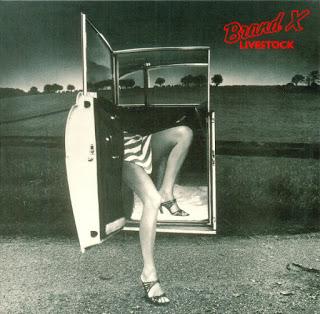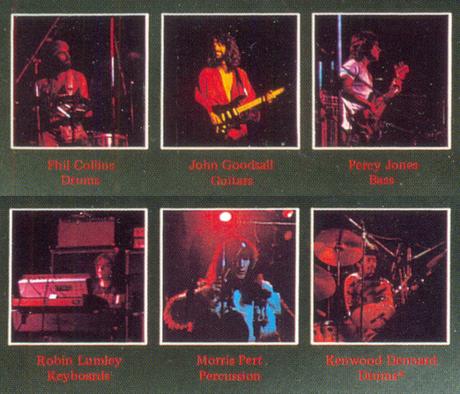
#Músicaparaelencierro. LightbulbSun nos recuerda un disquito que hace tiempo nos había presentado Callenep. Tres temas en vivo y dos tracks de estudio de tiempo antes. Livestock es un buen registro en vivo de Brand X con la alineación de sus dos primeras producciones, Unorthodox Behaviour y Moroccan Roll, además de un par de temas con un nuevo baterista que tomaría el lugar de Phil Collins. Siendo un "live", tiene la ventaja de traernos temas originales de la banda que no quedaron plasmados en ninguna producción de estudio. Suena con bastante claridad (aunque algunos críticos se quejan de lo contrario); se trata de una grabación limpia de conciertos que se dieron en diferentes fechas y lugares de Londres entre 1976 y 1977. Por tanto, pueden sentirse ligeras diferencias en la ecualización, pero el lenguaje de la banda predomina. Como sucedió con el tema "Why Should I Lend You Mine..." del Moroccan Roll, estamos ante la ejecución directa, sin trucos de estudio, que nos muestra a una estupenda banda de fusión.
Año: 1977
Género: Jazz Rock / Fusión
Duración: 41:32
Nacionalidad: Inglaterra

Livestock es también el primer disco de Brand X en el que Phil Collins no aparece en todas las pistas. Estando su participación siempre comprometida por los compromisos con Genesis (más o menos es la época de promoción del Wind & Wuthering), en dos de los temas del disco (el primero y el último, grabados en el Hammersmith Odeon el 5 de agosto de 1977) Brand X trabaja con el baterista Kenwood Dennard, y hay que decir que cumple coabalmente con el cometido.
El tema inicial, “Nightmare Patrol” es uno de los inéditos que se incluyen en Livestock. Con bastante improvisación, tenemos a la dupla del bajo fretless de Percy Jones con el nuevo baterista, desarrollando un tema muy libre y de gran fuerza y creatividad. Lo sigue otro inédito, “-Ish”, grabado en el Ronnie Scott's Jazz Club de Londres en septiembre de 1976. En este corte se destaca de un modo impresionante la habilidad improvisativa de Collins, y tiene también una participación muy interesante del guitarrista Goodsall, tanto en sonidos distorsionados como en una guitarra más jazzística, de sonido puro que por momentos recuerda el sonido Metheny, siempre sobre el jugueteo armómico de los teclados, en especial el piano Fender Rodhes. También hay buenos ejemplos de solo en sintetizadores del tecladista Robin Lumley.
El tercer tema (cerraba el lado A del vinilo) es un ya conocido de los seguidores de Brand X: “Euthanasia Waltz”, del primer disco. La grabación es de abril de 1977 en el mítico Marquee de Londres. Una excelente ejecución de un tema del que ya habíamos destacado cualidades en el post de Unorthodox Behaviour. Esta ejecución en vivo no presenta gran diferencia con el original de estudio, si bien escucharlos en el entorno de concierto hace la experiencia más resaltante. Los cambios armónicos que caracterizan el tema, planteados al alimón por Goodsall y Lumley, son mucho más claros aquí, y queda como un tema breve (cinco minutos y medio) que podría haberse dejado extender sin llegar a la monotonía (ventajas del compás de 3/4).
El lado B del vinilo, tenía originalmente solo dos pistas, pero en el CD, la minisuite, “Isis Mourning (Part 1 & 2)” ha sido separada en sus dos partes como tracks independientes. Es otro de los temas no grabados en estudio (se grabó en el mismo concierto que “-Ish”, de septiembre de 1976); en conjunto, ambas partes sobrepasan los nueve minutos, iniciando con un arranque más bien atmosférico en el que se puede sentir el trabajo de percusión incidental de Morris Pert sobre los climas que fabrican Jones, Goodsall y Lumley. La segunda parte del tema aterriza por fin en un beat más preciso, si bien aún con aires etéreos. En lo particular me resulta enigmático que este tema no haya sido grabado en estudio porque es quizá mejor que algunos de los aparecidos en los tres primeros discos de la banda (los dos mencionados y el Masques, que pronto tendremos en el blog). La segunda parte está basada en una figura sin terminación específica (por la apertura de su armonía) que permite la improvisación a todos los músicos, extendiendo a veces la duración de la coda en cada vuelta. En alguno de esos espacios, aparece un Collins rompiendo el ritmo de una manera realmente notable.
El disco cierra con otro tema ya conocido, el “Malaga Virgen” del Moroccan Roll, de nuevo sin Collins. La batería de Kenwood Dennard vuelve a demostrar en esta casi samba por qué se ganó el puesto, especialmente en las partes al unísono de vértigo en que se acoplan todos los músicos.
En resumen, otro buen disco de Brand X, en su expresión en vivo, con buenos temas inéditos y una limpia producción. Como verán en las reseñas de abajo, no a todo el mundo le gusta; en mi visión personal de la música Brand X representa un esfuerzo notable en un país, Inglaterra, donde el mercado del jazz fusión era estrecho y estaba copado por actos de extremo vanguardismo como Soft Machine. Yo veo en Brand X un lugar donde confluyen el jazz y el rock con un influjo que proviene directamente de la tradición progresiva inglesa, y eso es algo que no está tan presente en el jazz fusión estadounidense.
El único pero que yo le pondría a este disco es conceptual y no musical: si bien “livestock” puede ser un buen juego de palabras para mencionar que se trata de material guardado que sale a tocarse en vivo, la carátula muestra una surrealista puerta de limusina flotando ante una pradera, de la que se asoman las piernas de una bella mujer, en blanco y negro, por lo que necesariamente se establece ese otro significado de la palabra “livestock” (reserva animal, por decirlo con tanta elegancia como es posible), dejando muy mal parados a músicos, productores y diseñadores gráficos en términos de un machismo rampante y una objetualización de la mujer. Otras carátulas de Brand X son sexys; esta es un error (y también es de Hipgnosis).
Referencias:
Dave Connolly (Allmusic) informa aquí que los temas "-Ish" y "Isis Mourning" fueron grabados en estudio, pero en ninguna otra parte se hace esta referencia, dándose por grabaciones vivas en todos lados:
Lest the momentum of Moroccan Roll and its relative chart success go to waste, Brand X released a stopgap solution with Livestock, featuring three recent live tracks and two stockpiled studio tracks that actually predate the Moroccan Roll sessions by two months. As might be expected, it's not their most enduring work, although the inclusion of three new originals and the clean recording obtained from the Hammersmith Odeon and Marquee Club performances produce respectable results. Two of the three live tracks feature drummer Kenwood Dennard, who lends his superlative skins to the smooth fusion of "Nightmare Patrol" and a frenzied reading of the popular "Malaga Virgen." (Genesis had finished their tour that same year, so you can't begrudge Phil Collins the holiday.) Collins' lone live appearance occurs on the two-part "Isis Mourning," which begins as an atmospheric piece punctuated by Pert's percussion and Percy's popping bass before stabilizing in the second part under Collins' steady rhythm. The two studio tracks are "-Ish," a hazy and occasionally funky jam that initially borrows the bassline better known from "Malaga Virgen," and an alternate version of "Euthanasia Waltz" that skips lightly over familiar terrain. The drum section remained in flux for their next album, as Collins took a brief hiatus from the band and Dennard continued to build his jazz resume on albums by Jaco Pastorius, Larry Coryell, Miles Davis, and Sting. While Livestock is arguably the least essential of their first seven albums, fans shouldn't be discouraged from picking this one up.
A Daveconn (ProgArchives) no le gustó:
The live adventures of the mathematically minded and mellow-eastern Brand X. Livestock is one of the most subdued-sounding live albums I own; percussion percolates, basses bubble, keyboards creep and guitars growl in this arid, exotic landscape. Concert albums that feature new material (as this does) are interesting animals, and a very different animal than The Bruford Tapes. Bruford's live album was raw, raucous and familiar. Livestock is a calculated exploration of old terrain and new lands. It's a little like getting half a new album with some live versions tacked on, as close to an EP as sits on the Brand X shelf. Thus it's the least essential of the first four albums. The timing of its release is also questionable. Was the clamor for another Brand X album so great after six months, or did Charisma see Livestock as a last opportunity for the band to cash in on Collins' cachet? Collins himself is replaced by Kenwood Dennard on two tracks, perhaps because of conflict with the Wind & Wuthering tour, and this does effectively answer the question many people were asking of where Collins' loyalties would lie when push came to shove. Genesis came first, Brand X second, and the third album all but stated that. So Livestock is at the same time a short celebration and a slight hissing of air from the Brand X balloon. After you've purchased everything up to Product, looking in Livestock for something to snack on is the logical next step. Personally, I prefer my fusion more explosive. The music of Livestock, like Soft Machine, consists more of gentle eruptions and complex patterns, typical of music constructed by keyboardists and drummers. The subsequent Masques has more soul and spirit, so feel free to skip ahead and save Livestock for another day.
Sean Trane (ProgArchives):
Generally, live albums are often released to provide the bands some more time before the next studio album's release, but it's not always the case. Releasing a live album is also a cheap way of releasing a record, without too much studio expenses, but it's even worthier if most of the tracks are previously unreleased and such was the case of Livestock. Apparently recorded over (at least) two dates over the 76-77 years, since there is a drummer change, as Collins is missing out on two tracks (holidays are over, time to return to the day job), Ken Dennard filling in. (Ex-Pat Martino). The artwork shows a disgustingly rachitic woman's pair of legs coming out of a door and is no hint for the music.
Livestock is their third album and if it was recorded live, only two tracks were from previous albums. But the rest of the (unreleased) tracks are right on par with the excellence of their first two albums. Nightmare Patrol is, along with Macrocosm and Nuclear Burn, one of my fave tracks of BX. Next up is "?ish" and a personal favorite, slightly Santana-esque and the best of the new tracks. Both Euthanasia and Malaga Virgen (the only two tracks previously known) are rendered better in live than in their original studio versions. The lengthy two-part Isis Mourning is a delicate slow blues starter and is quite accessible.
This is the first album where Mr. Collins is not fully present (well, he did have a day job in a firm called Genesis) and his future coming and going will affects the cohesiveness of Brand X, IMHO. But in the meantime, he remains on the stool for most of this album, and he's brilliant.
Guitar Nine:
"Livestock", released just after the first two Brand X studio albums, was recorded live at Ronnie Scotts in London (September, 1976) and at the Hammersmith Odeon and the Marquee Club in London (August, 1977). Since the band was comprised of musicians with a fair amount of concert experience, it's no wonder these performances translate well from studio to stage. Here you'll find songs like "Euthanasia Waltz" from "Unorthodox Behaviour" and "Malaga Virgen" from "Moroccan Roll ", but the other four tracks represent material not found on their first two recordings. Some wonderful spacey fusion here, plus the requisite harder moments courtesy of John Goodsall and his guitar.
George Starostin (el chico de la prosa chispa que no adora a Brand X):
This is a live album, or at least it seems like a live album, but according to what I've read, it's really a mess. Some newly-recorded studio tracks are interspersed with some newly-recorded live tracks that date from different venues featuring different drummers, and to make matters even more complicated, the newly recorded tracks in fact date to pre-Moroccan Roll times, and the album cover is unusually sexy for a fusion record too.
Apart from the Mess factor, though, Livestock isn't terribly entertaining. To say that the formula of Brand X had wearied thin would be an insult to all the fusion fans in the world, because if it weren't Brand X but, say, AC/DC, I'd find myself thoroughly embarrassed saying that. I can't really suggest, though, that this is live playing of the highest order - the band seems to willingly put itself in a trance most of the time, with the vibe being laid back and vaguely lazily swaying through the dusky horizon, if you pardon my gibberish; only on the closing 'Malaga Virgen' do they actually pick up the old steam, with Collins' temporary replacement Kenward Denneth pushing and propelling the solo players forward to give 'em their best shot.
Phil is featured only on one two-track long suite, 'Isis Mourning', which is a bore; maybe in a live setting it was stunning, but here it's just a slow meandering jam with lots of avantgarde dissonance throughout (you know, one of those numbers that's so painful to hear with an ear untrained to masochism because it seems like the band is cracking at the seams and is going to just crash to the ground the very next second) that sounds the same through all of its nine minutes; lightning strike me if I know what the hell really separates 'Part One' and 'Part Two'. I have to admit, though, that Phil's percussion work is very interesting here and is pretty unusual even for his stature in Brand X; he's mixing jazz percussion with what I'd describe as "slight tribal beats", and I never heard him doing something like that anywhere else. But that's not as much of an inspired compliment as just a statement of fact.
Again, as usual, there's at least one truly inspired composition that gets my applause for combining an interesting melody with gorgeous atmospherics, and that's the album opener, 'Nightmare Patrol', which doesn't sound half that evil as the title suggests. It's just a mid-tempo soft-jazz shuffle, but with a very warm and inviting synth tone and a cute little friendly synth riff that keeps popping up at all the right places. Some more finger-flashing guitar solos and a good spotlight for the bass player and you're all set. But then it segues directly into '-Ish', and all the friendly evening atmosphere dissipates in favour of pretty generic "fusioneering", with predictable bass lines, predictable drumming, and predictable diddly-diddly synth wanking. It's pretty stupid how, out of two consequent fusion compositions by the same band, one can delight me so much and the other doesn't leave even a tiny impression, but you know, that's just the way it is. I guess it's all because of that nice nice synth riff in 'Patrol' - the link to tie everything together. Like 'Nightmare Patrol' is a solid tree trunk with numerous branches covered with green leaves attached (that's when the members run off in all directions), and '-Ish' is just a heap of disconnected branches. So there. That's my banal allegory of the day, hope you like it and now I can go on.
Well, actually, there's nowhere left to go on, the only track I haven't discussed yet is an alternate version of 'Euthanasia Waltz', but I'd be a complete dork if I started dedicating web space to alternate versions of 'Euthanasia Waltz', so instead I'll play a Mark Prindle and say, to hell with 'Euthanasia Waltz', let's talk about euthanasia instead. Are you for or against euthanasia? Me, I'm basically pro, because when you come to think of it, abortion is a bigger crime than euthanasia (hey, you don't actually ask permission from that ovum!), and abortion still lives on. Then again, I guess if euthanasia were permitted, I'd just take the easy way out because I just saw a Britney Spears special on TV and that's way harder on me than lung cancer could ever be.
Seriously, though, 'Malaga Virgen' isn't half bad in this live setting. It actually rocks, which is more than I can say for Frank Sinatra.
Lista de Temas:
1. Nightmare Patrol
2. -Ish
4. Isis Mourning Part One
5. Isis Mourning Part Two
6. Malaga Virgen
Alineación:
- Phil Collins / Batería (2-5)
- John Goodsall / Guitarras
- Percy Jones / Bajo
- Robin Lumley / Teclados
- Morris Pert / Percusiones
- Kenwood Dennard / Batería (1 y 6)

